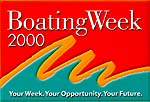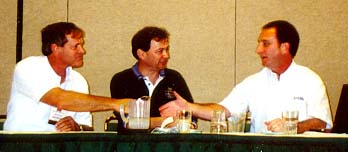 |
What's New in Marine Engine Technology
|
 |
 |
What's New in Marine Engine Technology
|
 |

 |
The PanelRick Davis at Mercury Outboard, Rick Broughton Chief Engineer at OMC, Dave Grigsby Product Manager at Yamaha
|

Rick Davis at Mercury Outboard:
He showed a chart of engine and drive weight vs. total horsepower. Three generally parallel curves started at the lower left and rose to the upper right. Outboards were on top, followed by 4 stokes or high output automotive engines and stern drives were the bottom curve.
RBBI Note: I requested a copy of the graphic.He said he would ask for clearance to send us one.
Stern drives are lower cost. Outboards have a higher horsepower per pound ratio.
The new marine engine paradigm. Agencies have forced a rationing effect on outboard emissions by year. There is a step in the curve at 2001, 2004 and 2008. We have to keep changing (improving) our averages.
They are moving from carbureted engines to EFI and then to more DFI engines.
CARB (California Air Resource Board) wanted to pull the 2006 requirements forward to 2001. Everybody is meeting the requirements with new engines (new designs), but not with old existing designs.
In California you are awarded one to three stars to put on your engine depending on which standards it meets. You can see the stars on the back of most outboards.
Mercury's Quest for Environmental Excellence is now yielding great improvements in terms of the cumulative effect of High Performance clean outboards.
There is a chart in Mercury's booth showing which engines earned which rating in California. They now have more three star offering outboards than any other manufacturer. The chart also shows the competitors.
He showed a chart indicating fuel efficiency vs. boat speed for the Optimax vs. a Honda four-stroke and an OMC Ficht engine. A properly calibrated two-stroke can actually be more efficient that an EFI four-stroke.
Brunswick's president, George Buckley, has stated, "Innovation and the best cost manufacturing are the key to our success in the marketplace."
They now have a big push in four strokes. Selling about 50 percent more four-strokes this year.
The "hot rod" PCM 555 control module has worked very well for them.
Mercury has a new NVH (Noise, Vibration and Harshness) Lab in Fon-du-lac.
"Mercury is the absolute leader in environmentally friendly marine engines. We live on the planet too."

Dave Grigsby Product Manager for Yamaha:
They had 19 qualified engines, added 17 for 2001.
They will have 104 outboard models in 2001.
The VMax is high performance oriented. The Premium Model HPDI is for fresh water or salt.
Their 700 psi direct injection system is the highest pressure in the industry.
They have an oxygen sensor on the exhaust to feedback and change injection rates.
Not having the intake and exhaust ports open at the same time makes the HPDI engines much quieter than conventional two-strokes.
Four-strokes are taking this country by storm. They are cleaner, more convenient and durable.
Here at the show, Yamaha is introducing the world's first V6 four-stroke 225 HP unit.
They reversed the water intake and exhaust. Moved the intake to the outside of the V and the exhaust to the inside of the V.
It uses a 60 degree block, Twin DOHC, 24 valves, 6 individual intake tubes.
No more 3 gallon oil tanks needed in the back, plus no more carrying all that spare oil.
Consumers could save $200 a year in oil costs alone.

Rick Broughton OMC Chief Engineer
Where do we go from here from an engineering perspective? Fuel consumptions can be measured to make about any point you want to make. ICOMIA fuel consumption figures follow a strict duty cycle they have found to closely match real use. It offers uniformity for comparison. It is a good way to compare fairly.
Boater Primer: looking for fun, value, quiet, smooth, clean, reliable, efficient, hassle-free boating.
He began speaking about the various engine designs (carbureted two-strokes, EFI two-strokes, carbureted 4-strokes, 4 stroke EFI, etc) and how each one rates when stacked up against a specific emission criteria (hydrocarbons, nitrogen oxides, carbon monoxide emissions, etc) and other design criteria. For example two-stroke carb engines are the cleanest when considering nitrogen, but they pay too much of a hydrocarbon penalty.
When you nail a two stroke you have fun (high specific power). You don't want to "hit it" and say this is no fun. Two strokes are good at specific torque.
Using perhaps 8 of these criteria against the various designs, he showed a slide with a matrix of the criteria down the left side and the engine types across the top. Each cell had a rating (poor, fair, good, excellent, etc) and was "colored in" by the rating. The engine types with the most green cells in their column were the best opportunities for the future.
RBBI Note: After the presentation, I asked him for a copy of the slide. He said he would ask for approval and forward one if possible.
The longer you work on something, the harder it is to squeeze anything out of it. They only squeezed DFI once. They can get some more from it.
With DFI, their are only two problems left: Hydrocarbon emissions and improving low RPM sound.

John McKnight leads a task force in Washington and California with a three pronged approach
to keep the regulations where they are currently set (keep the timeliness for future improvements
as they know are).
Yamaha - the jet drive market is controlled by one company making the shoes. Yamaha is moving from two-stoke to four-stroke jets. Pennsylvania (state) is second biggest consumer of water jet boats.
Two-stroke jet drives burn more fuel. (The jet drive itself is a bit inefficient compared to a prop drive, combine that with the two stroke and much more fuel is consumed.)
Mercury - never a big market for outboard jet drives. Never a big push in that area.
Merc was successful with the combined flow pump they sell to Bombardier. This year it has an Optimax power head on it.
One member of the audience kept asking about bigger jets. Mercury said they might move up to 200 to 300 HP.
OMC - Yes, Kerosine.
Merc - Hydrogen and LP are distribution oriented. Direct injection is more friendly to alternative fuels.
The marine industry will follow automotive fuel distribution. They watch octane very carefully or people would get in trouble with normal pump gas.
Originally the industry was really worried about the cost of four-strokes and DFI, but despite the price tag, people are buying them. The customer gets fuel economy payback and they run better.
Merc- New 8.1 has PCM 555 controller with and uplink to the smart gauges. All three engines have standard laptop diagnostic tools.
OMC- we were the first to introduce laptop diagnostics. At first they were concerned about remote areas and emerging nations. But seems like everybody has a laptop, generator and cell phone in their hut.
Pressurizing and cooling the fuel goes a long ways toward helping reduce fuel problems.
Two-stroke will stay around for years for bass boats and performance.
OMC /Yamaha - None.

RBBI Comments:
A few elements of all three presentations were a bit too commercial for me.
But, at least two of them contained some very interesting technical materials as well.
Looking back over my notes, it looks like Mercury side stepped the GM engine question. I don't think he really did.
I especially enjoyed the insights into how they chose which engine designs to pursue shared with us by Mercury and OMC. Hopefully they will share their graphics with us and I can post them.
We look forward to other presentations with some "real meat" in them like this one.

Return To Boating Week 2000 Main Page

Return to RBBI Home Page